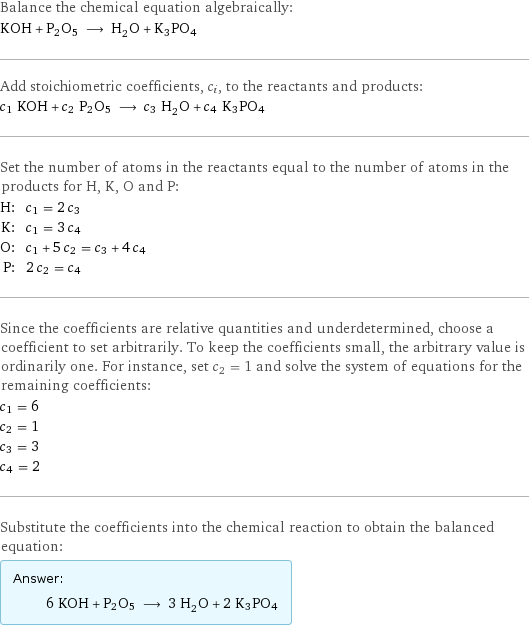Input interpretation

KOH (potassium hydroxide) + P2O5 ⟶ H_2O (water) + K3PO4
Balanced equation

Balance the chemical equation algebraically: KOH + P2O5 ⟶ H_2O + K3PO4 Add stoichiometric coefficients, c_i, to the reactants and products: c_1 KOH + c_2 P2O5 ⟶ c_3 H_2O + c_4 K3PO4 Set the number of atoms in the reactants equal to the number of atoms in the products for H, K, O and P: H: | c_1 = 2 c_3 K: | c_1 = 3 c_4 O: | c_1 + 5 c_2 = c_3 + 4 c_4 P: | 2 c_2 = c_4 Since the coefficients are relative quantities and underdetermined, choose a coefficient to set arbitrarily. To keep the coefficients small, the arbitrary value is ordinarily one. For instance, set c_2 = 1 and solve the system of equations for the remaining coefficients: c_1 = 6 c_2 = 1 c_3 = 3 c_4 = 2 Substitute the coefficients into the chemical reaction to obtain the balanced equation: Answer: | | 6 KOH + P2O5 ⟶ 3 H_2O + 2 K3PO4
Structures

+ P2O5 ⟶ + K3PO4
Names

potassium hydroxide + P2O5 ⟶ water + K3PO4
Equilibrium constant
![K_c = ([H2O]^3 [K3PO4]^2)/([KOH]^6 [P2O5])](../image_source/673264b48507721e3dece386347f00ab.png)
K_c = ([H2O]^3 [K3PO4]^2)/([KOH]^6 [P2O5])
Rate of reaction
![rate = -1/6 (Δ[KOH])/(Δt) = -(Δ[P2O5])/(Δt) = 1/3 (Δ[H2O])/(Δt) = 1/2 (Δ[K3PO4])/(Δt) (assuming constant volume and no accumulation of intermediates or side products)](../image_source/bdc5e1ddc5571721a9ab7763f2f3f0b1.png)
rate = -1/6 (Δ[KOH])/(Δt) = -(Δ[P2O5])/(Δt) = 1/3 (Δ[H2O])/(Δt) = 1/2 (Δ[K3PO4])/(Δt) (assuming constant volume and no accumulation of intermediates or side products)
Chemical names and formulas

| potassium hydroxide | P2O5 | water | K3PO4 formula | KOH | P2O5 | H_2O | K3PO4 Hill formula | HKO | O5P2 | H_2O | K3O4P name | potassium hydroxide | | water |